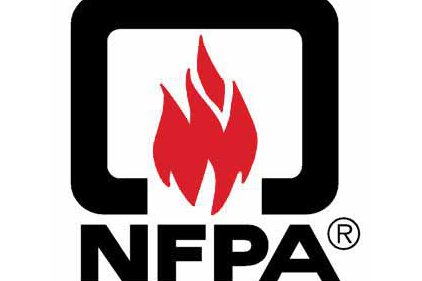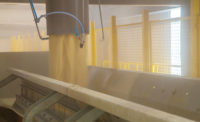NFPA 654: Standard for the Prevention of Fire and Dust Explosions from the Manufacturing, Processing, and Handling of Combustible Particulate Solids contains comprehensive guidance on the control of dusts to prevent explosions. The following are some of its recommendations:
- Minimize the escape of dust from process equipment or ventilation systems;
- Use dust collection systems and filters;
- Utilize surfaces that minimize dust accumulation and facilitate cleaning;
- Provide access to all hidden areas to permit inspection;
- Inspect for dust residues in open and hidden areas, at regular intervals;
- Clean dust residues at regular intervals;
- Use cleaning methods that do not generate dust clouds, if ignition sources are present;
- Only use vacuum cleaners approved for dust collection;
- Locate relief valves away from dust hazard areas; and
- Develop and implement a hazardous dust inspection, testing, housekeeping, and control program (preferably in writing with established frequency and methods).
When all of the recommendations of NFPA 654 are met and the potential for dust explosions is still present, an explosion prevention system should be applied to the process areas where needed.
Major changes to NFPA 654 include new administrative requirements
The Standards Council of the National Fire Protection Association (NFPA), Quincy, Mass., issued the 2013 revision of the NFPA 654 "Standard for the Prevention of Fire and Dust Explosions from the Manufacturing, Processing, and Handling of Combustible Particulate Solids." This standard applies to all combustible particulate solids or hybrid mixtures, regardless of concentration or particle size, where the materials present a fire or explosion hazard. The owners or operators of affected facilities are responsible for implementing the requirements.
The 2013 edition has incorporated a number of changes. These include administrative controls such as safety-management practices, added training requirements for contractors and subcontractors, and incident investigation and reporting requirements. Important sections regarding housekeeping programs and hierarchy of cleanup operations also are included in this revision. This is an important area because incident history and statistics clearly indicate that secondary dust explosions — caused by inadequate housekeeping and excessive dust accumulations — have cause much of the damage and casualties experienced in major industrial dust explosions.
Incident investigations
There now are requirements for investigating incidents that result in a fire or explosion of a magnitude that causes property damage, production downtime or injury. Section 4.4 of the revised standard mandates preparing a written report that describes the incident, lists what has been learned, and includes recommendations to prevent future occurrences.
Additionally, the summary of the report must be shared with affected personnel operating, maintaining and supervising the facility.
Housekeeping program
Section 8.2 outlines requirements for a formal housekeeping plan.
• The Layer Depth Criterion Method. This establishes a baseline combustible dust accumulation based on the dust's bulk density. It adjusts the previous benchmark dust accumulation level (2006 Edition) of 1/32 in., which was based on a dust with a bulk density of 75 lb/ft3, by multiplying 1/32 in. by 75 lb/ft3 and dividing the number by the bulk density of the site's dust to establish a new threshold accumulation thickness. (Thicker layers are allowed for lower density materials.)
The total area of nonseparated dust accumulation can't exceed 5% of the footprint area and the total volume in the footprint area can't surpass the layer depth criterion multiplied by 5% of this area. (For areas greater than 20,000 ft2, the maximum accumulations and total volumes are based on a footprint area of 1,000 ft2.) For example, in a room with an area of 1,000 ft2 where dust having a bulk density of 37.5 lb/ft3 has accumulated, the layer depth criteria is 1/16 in. and the accumulation of dust in the room can't surpass 1/16 in. over 50 ft2.
Additionally, the total volume of dust in this room can't exceed (1/16 in.)/12 in./ft×50 ft2 = 0.26 ft3 or 9.77 lb.
• Mass Methods A and B. Method A relies on an equation to calculate the threshold dust mass accumulation based on floor area and room height. Method B provides a number of parameters, including room area and height, room or enclosure design strength, dust explosibility and entrainment factor.
Method B has been adapted from the NFPA 68 "Standard on Explosion Prevention by Deflagration Venting," which adjusts the amount of venting needed when the combustible mixture only fills part of the room and also considers explosion dynamics based on the properties of the dust of interest.
•A risk evaluation method acceptable to the authority having jurisdiction. This method affords increased flexibility to an evaluator when assessing the hazard.
The risk assessment, which must be performed by a competent professional, must show that the proposed strategy will achieve the same result as prescriptive methods. It's based on scientific facts and test data generated on the combustible dust(s).
This approach can be a very important alternative to the first three methods for industries that generate significant amounts of combustible dusts due to the inherent nature of their manufacturing operations or where dust control or cleanup may present substantial challenges.
The risk-based approach considers the physical, chemical, explosibility and ignitibility properties of a dust as part of the overall risk assessment.
For example:
?Is the combustible dust very difficult to ignite?
?Does it have very weak explosibility properties?
?Does the nature of the dust particle (size and shape) make generation of a combustible atmosphere improbable?
?Is an ignition source likely that could produce incentive sparks and hot surfaces? These are some of the factors that are considered in determining whether an explosion hazard exists in a plant.
Section 8.2 requires implementing a planned inspection process to evaluate dust accumulation rates and housekeeping frequencies to prevent threshold accumulation levels from developing on walls, floors, horizontal surfaces such as equipment, ducts, pipes, ledges, beams, above suspended ceilings and other concealed surfaces, for example, electrical enclosures
Sources:
National Fire Protection Standard 654, 2013 edition
Identifying the relevant NFPA standards on combustible dust
Combustible dust can be a dangerous hazard. Follow these guidelines to keep you and your workers safe.
Tony Supine & Mike Walters, Camfil Farr APC
06/08/2012
Dust Explosion Standard Gets Significant Revisions
Major changes to NFPA 654 include new administrative requirements.
By Steven J. Luzik, Chilworth Technology, Inc.
Aug 13, 2013



